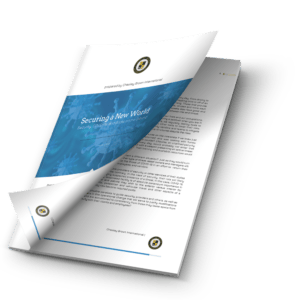Small changes have a big impact.
As a public health crisis of worldwide proportions comes into focus, it is imperative for individuals, organizations, and nations to develop effective resilience strategies, including communications and outreach as part of any comprehensive crisis management plan.
Chesley Brown has responded to the COVID-19 crisis by making our Resource Center available to the public. It provides professional advice, enterprise tips, workflow suggestions, and updates on handling the coronavirus crisis and more. I highly recommend you check it out.
In this section, we present 10 recommendations for corporations to understand the crisis landscape, prepare internal groups with a messaging strategy, and suggestions for interacting with more than a few stakeholders. They are drawn from our very own experience, and that of our vast network of global resources on crisis management.
Step 1: Study the nature of the crisis.
A crisis of any size, scope or dimension can strike at any time creating chaos and sowing confusion. In order to mitigate or eliminate the impact a crisis may have it helps to map out the landscape. Some crises are internally caused (eg. defective products), others are external in nature (eg. the spread of infectious disease). Some will have a local impact, others are global in scale.
Some crises have an effect on specific communities or demographics, others will target the general public at large. Each of those dimensions should inform and influence your objectives, team composition, and available options. What the cause, its important to include a variety of contingencies with in your crisis management plan.
Step 2: Map of the information landscape.
Simply testing a disaster plan with senior board members substantially reduces both the number of crises as well as the negative consequences when they do arise — 21% of enterprises that include board members in their crisis management plans reported a decrease in the number of crisis situations they faced, compared to only 2% of the control group. This has the added benefit of creating an open framework for dialog as well as buy-in from each of the stakeholders.
Unfortunately, similarly to breaking news in a time of disaster, there can be an alarming volume of fake news, misinformation, hate speech, and unsubstantiated rumours. Crisis analysis begins by separating authoritative sources from dubious sources. Local, national, and international authorities should be the primary sources for important information.
By leveraging the principles of Knowledge Management, you may be able to better classify content material into facts, records, and know-how. With information breaking all the time, it is critical to update response tips and procedures to maintain accuracy and relevance in your crisis management plan.
Statistics should play a vital role in prioritizing action. This will also allow you to plan future action based on projections. Designing and visualizing information into an understandable way is a powerful method for communicating eventualities with a wide variety of audiences. This could consist of image design, interactive charts and infographics, or press clippings.
Step 3: Understanding the media.
Every business should be in charge of its own digital footprint, and also understand how to engage with the media. Major traditional media typically have wide ranging influence and authority, but have also been known to make mistakes; hence “media literacy” is an important competence.
Social media is a rich platform for the “people’s voice” and also another important channel for communicating. Social media monitoring and outreach help you keep a finger on the pulse of your audience, while minimizing the barriers to direct communication.
Step 4: Build a crisis management team.
Though plans may change, it is essential to have a crisis communication team on location to adjust and plan messaging, online assets, and other activities. The organizational leader and spokespersons have to be the center of this group, but organization-wide support and inputs are also needed. It therefore makes sense to utilize a cross-functional team to build and vet your communication strategy.
Communication to inner and outside stakeholders ought to be at regular intervals (eg. every morning or evening), along with additional emergency bulletins as relevant. Sensing, sensemaking, and articulation should be executed in a systematic manner.
Communication channels for strategic communication have to be prioritized in your crisis management plan. The ultimate goal is to transition from responsive communication to proactive engagement.
Step 5: Use the Five Fundamentals of Crisis Communication.
- Have a plan.
- A crisis communications plan can help ensure accurate records immediately get to decision makers, accelerating response times and keeping the organization’s decisions firmly grounded within its vision and ideals. The reason awful crises get genuinely awful is they are allowed to fester due to the agency’s reluctance to admit that a crisis is happening. An effective crisis management plan protects against that. It would be misguided to assume all organizations have been diligent in proactively crafting their crisis management plans and communication strategies for a variety of situations, but the truth is most organizations set about creating their plans under one of three situations:
- Immediately following a crisis (whoops)
- After a near-miss (that was close!)
- After a similar organization has experienced a crisis (Better prepare)
- The point is, don’t create your plan under duress. You’ll only be faced with bad decisions. In these situations you will rarely be afforded a chance to catch your breath, let alone think objectively.
- A crisis communications plan can help ensure accurate records immediately get to decision makers, accelerating response times and keeping the organization’s decisions firmly grounded within its vision and ideals. The reason awful crises get genuinely awful is they are allowed to fester due to the agency’s reluctance to admit that a crisis is happening. An effective crisis management plan protects against that. It would be misguided to assume all organizations have been diligent in proactively crafting their crisis management plans and communication strategies for a variety of situations, but the truth is most organizations set about creating their plans under one of three situations:
- Know the facts first.
- In order to make the best decisions you must have objective information freely available. There are few things that are more dangerous to an organization’s reputation than publishing information during a crisis that turns out to be wrong. Once trust is gone, the entire organization is in serious peril.
- Own it.
- With very few exceptions, it is better for a company to report its own bad news. This offers you an opportunity to ‘frame’ the story and provide the right context. This inevitably becomes a tussle between public relations and legal counsel. There are strategies to work through these tensions, especially if organizational leadership can be convinced that the whole story will eventually come out, which it will.
- Be human.
- We have helped countless organizations navigate various crises over the years and we’ve seen firsthand how tough it is for executives to be compassionate. It is always easier to speak about the problem and all the hassle it creates than it is to acknowledge that people are suffering. Showing everyone dignity and empathy in times of crisis goes a long way, and it’s one of the best ways to endear your company to employees and customers.
- Speak with one voice.
- This is the end result of encouraging the free exchange of information as defined above. In the midst of a disaster and in the immediate aftermath, every person associated with the organization should be considered a spokesperson. They may not present information formally on behalf of the organization or step to the podium at an industry conference, however, each and every employee has a different sphere of influence. In the age of social media and instant messaging, you cannot underestimate how quickly information will travel. Ensure all employees have accurate facts and outfit them with Q&As to guide them in conversations. After all, nearly every person with whom they interact is a social media consumer and can amplify your messages.
Any effective crisis communication plan will include each of these 5 fundamentals. In addition to serving as a framework for building your communication strategy, they will help you make decisions as you plan your next steps. Transparency is key in disaster conversations; data should not be fudged, manipulated, or hidden. In order to cultivate trust among internal and external stakeholders, you must demonstrate that facts matter and everyone’s opinion and contribution counts.
Step 6: Understand audience worries.
High-intensity crises have an effect on society at a couple of levels, especially in an era of globalized work and migration. In addition to worries of residents and families, employees and consumers expect to be factored in to any decisions that may affect them. Crisis communication must communicate to their needs, in addition to the needs of the most vulnerable populations like seniors and children.
Step 7: Media engagement.
For key announcements or even for ordinary conversation, organizations should have a way to interact with the media. This can vary from physical/digital press meetings to conversations on the green.
Help lines can be an effective strategy but they will need to be well staffed to give accurate and well timed responses to the media and to the general public, and online help desks must be informative, easy to use, and accurate. Websites and social media channels should cultivate a trustworthy, authoritative persona to calm any anxieties.
Step 8: Communicating with the wider ecosystem.
Crisis conversation inputs and outreach need to include key sectors of the broader economy, such as the health, retail, hospitality, and tourism sectors. Civil society and religious groups should be engaged in helping reinforce key messages. Celebrities or social media influencers can also be harnessed for purchasing buy-in from fanatics and broader communities.
Effective messaging should create a sense of security, compassion, and kindness. Always avoid laying blame, and instead focus on “why it’s just plain wrong” that your customers should have to deal with this issue and what can be done about it.
Step 9: Tell a compelling story.
Crisis communication requires calmness, seriousness, and empathy. In addition to statistical analysis and scientific research, use the key elements of storytelling to craft a narrative that is both informative and compelling. Using real life testimonials can help demonstrate compliance, innovation, and excellence (in addition to illustrating how not to do something).
Testimonials and “hero” statements evoke empathy, respect, and resonance. Humor can be really powerful at easing peoples’ fears, however, careful attention to context will help you avoid offending anyone. Errors and mistakes should be eliminated through thorough verification, proof-reading, and testing, in order to avoid harm to your organization’s recognition and credibility.
Step 10: Leverage digital transformation as a risk mitigation strategy.
One of the larger impacts of the current Coronavirus crisis on businesses is the acceleration of digital transformation. With so many employees now working from home using telecommute solutions like GoToMeeting, organizations are now exposed to a whole host of new vulnerabilities that we’ll cover in a later section. This rapid shift towards digital technology could potentially disrupt the entire organizational culture from collaboration to interactions with investors. The best prepared organizations continually assess the security, accuracy, and accessibility of their customer data, marketing collateral, income channels, logistics systems and any critical information systems that may affect their ability to conduct business.
The Bigger Picture
Humanity (and indeed, all species) has confronted and weathered a range of crises throughout history. In addition to operational impact, the larger socioeconomic fallout will take time to fully come into to focus. We should plan for the worst and hope for the best case scenarios.
Payroll, legal troubles, and compliance are other issues that organizations need to tackle head-on, in conjunction with policy and regulatory requirements from local, state and federal government. Many business owners struggle to fully grasp the myriad risks they face. That’s why we’ve built a framework that teaches businesses how to anticipate and navigate risk before it becomes a crisis. Despite the immediate hardships, a crisis is a messenger, and should be framed as an opportunity for introspection and reinvention. Be sure to download a free copy of Chesley Brown’s “The Business Continuity and Crisis Management Handbook” for our complete list of tips and strategies for preparing for and navigating a crisis effectively.
Posted by:
Sign up!
For industry-leading guides and analysis sign up for our blog below.
Latest News
6 New Risks for Businesses post COVID-19
Coronavirus: 6 New Business Risks Your risk management strategy can and should play an important role in managing your business’s response to the coronavirus outbreak. By implementing the right risk management strategies for coronavirus, your…
Read More5 Tips for Creating Better Crisis Management Plans
Like a lot of people, you may be wondering what comes next for your business or organization following the Coronavirus outbreak (or any other crisis for that matter). Well, you’ve come to the right place.…
Read MoreFREE DOWNLOAD Securing a New World: Security, COVID-19, and Boots on the Ground
There can be no argument that technology has infiltrated virtually every aspect of daily life for the vast majority of people and businesses across the world. Technology is woven into the social fabric of everyday life. It monitors our movements, our interests, our purchasing power, our locations, habits, our risk to insurers, our body chemistry, and health. Our images are captured overtly and unknowingly 1000’s of times daily. It captures the best of us in amazing acts of heroism and human interaction, and it captures the worst of us; for accountability and delivery of justice.
Read MoreWhen it Comes to Corporate Espionage, Harvard’s Dr. Lieber is Just the Tip of the Iceberg
When it Comes to Espionage Harvard’s Dr. Lieber is Just the Tip of the Iceberg From Chesley Brown International By Dell Spry Renowned Harvard Professor Arrested for Lying About Connection to China. Feb 5th, 2020…
Read MoreChesley Brown Launches Initiative to Fight Human Trafficking
Chesley Brown Launches New Initiative to Fight Human Trafficking From The Chesley Brown Group Risk Management Chesley Brown, the security management experts, announced today a new training initiative to provide support to victims, families, and…
Read More







